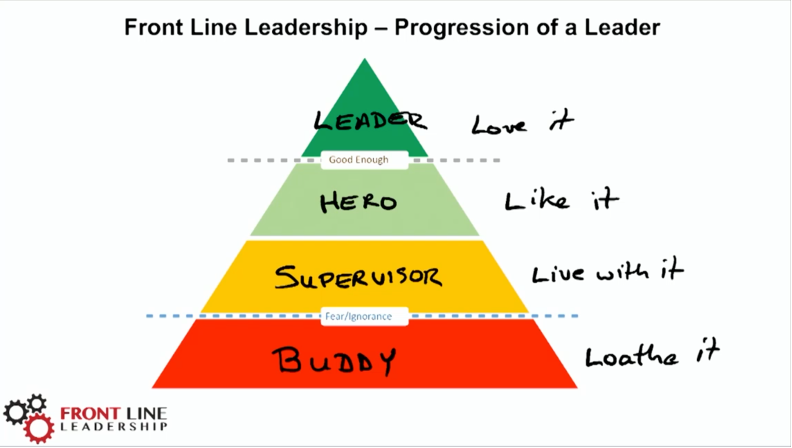What is a supervisor’s growth journey?
Let us examine our progression of a leader framework so as a leader, you can determine where you fit on this pyramid. If you are the manager, HR manager, or a team, you can examine it and see where your leaders fit on this pyramid, and how you can move them up in their capabilities and grow their confidence levels.

The Buddy
When a supervisor starts out, they will be in the red zone at the bottom of the pyramid. This zone is where we would call them a buddy. The person reluctantly accepts a promotion to team leader, they are not great at it, and they are not all in to learn how to improve.
At this point, they would loathe the position. That is why it is below the fear/ignorance line.
The Supervisor
Once you can get people over that fear/ignorance line and accept the fact that they are the front-line leader of their group, we would call them a supervisor. They go from loathing the position to living with it. They are not inspiring, and they are doing the bare minimum, but many organizations have people that are in this section of the pyramid.
The Hero
Once a leader wants to progress from there, they often take the path of becoming the hero. At this point, they are enjoying the role of being a leader. Think about what a hero does. A hero saves the day. They look out for their team. If the team needs resources, tools, and equipment, they go and advocate for their team. They get the team what they need to be successful. In that way, the team sees them as their hero.
What is a supervisor's growth journey? Let's examine our progression of a leader framework. Where do you fit on this pyramid? Share on XThe Leader
For many organizations, they call it a day at that point. But if they progress further to the pinnacle of leadership, then they will be labeled as a leader. This person has decided that they love their role. What makes them different from being a hero to their team is that they actually start to make heroes of other people. When they do this, those people get successful and this, in turn, drives up the culture and performance of your organization.
When you have people who are at that leader pinnacle, they are inspiring other people and many people want to emulate them. They want to emulate that leader, which means that they are going to inspire the next round of team leaders and supervisors in your organization and be ready to step up as your organization grows to meet customer demands.
If your leaders get to that level, your turnover rate will drop off and your retention rate will go up. Culture surveys will consistently have great feedback because your employees and team members are really going to appreciate what it is like to work for an exceptional leadership team.
That is what is at the pinnacle of the progression model. Not every leader is ready for that, but that is certainly what we do in our Front Line Leadership Program.
Start a conversation with us to see how we help your organization evolve and grow to exceptional leadership.

Leave a Reply